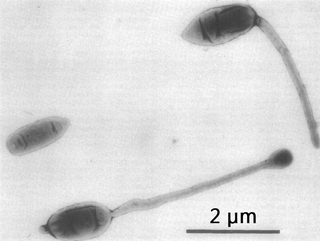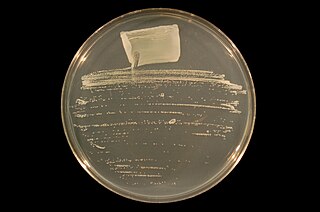Related Research Articles

Acidobacteriota is a phylum of Gram-negative bacteria. Its members are physiologically diverse and ubiquitous, especially in soils, but are under-represented in culture.

The Hyphomicrobiaceae are a family of bacteria. Among others, they include Rhodomicrobium, a genus of purple bacteria.

Alphaproteobacteria is a class of bacteria in the phylum Pseudomonadota. The Magnetococcales and Mariprofundales are considered basal or sister to the Alphaproteobacteria. The Alphaproteobacteria are highly diverse and possess few commonalities, but nevertheless share a common ancestor. Like all Proteobacteria, its members are gram-negative and some of its intracellular parasitic members lack peptidoglycan and are consequently gram variable.

Methylobacterium is a genus of Hyphomicrobiales.
Methylorubrum extorquens is a Gram-negative bacterium. Methylorubrum species often appear pink, and are classified as pink-pigmented facultative methylotrophs, or PPFMs. The wild type has been known to use both methane and multiple carbon compounds as energy sources. Specifically, M. extorquens has been observed to use primarily methanol and C1 compounds as substrates in their energy cycles. It has been also observed that use lanthanides as a cofactor to increase its methanol dehydrogenase activity
Methylorubrum rhodinum is a Gram-negative soil bacterium.

Ensifer is a genus of nitrogen-fixing bacteria (rhizobia), three of which have been sequenced.
Methylorubrum populi is an aerobic, pink-pigmented, facultatively methylotrophic, methane-utilizing bacterium isolated from poplar trees. Its type strain is BJ001T.
Methylorubrum zatmanii is a bacterium.
The Magnetococcales were an order of Alphaproteobacteria, but now the mitochondria are considered as sister to the alphaproteobactera, together forming the sister the marineproteo1 group, together forming the sister to Magnetococcidae.
Methylorubrum podarium is a Gram-negative bacteria from the genus Methylorubrum which has been isolated from a human foot in the United Kingdom.
Methylorubrum salsuginis is a facultatively methylotrophic bacteria from the genus Methylorubrum which has been isolated from seawater.
Methylorubrum thiocyanatum is a facultative methylotroph bacteria from the genus Methylorubrum which has been isolated from soil around the plant Allium aflatunense in Warwickshire in the United Kingdom.
Methylorubrum suomiense is a facultatively methylotrophic and aerobic bacteria from the genus Methylorubrum which has been isolated from forest soil in Finland.
Azospirillum is a Gram-negative, microaerophilic, non-fermentative and nitrogen-fixing bacterial genus from the family of Rhodospirillaceae. Azospirillum bacteria can promote plant growth.
Methylorubrum pseudosasae is a Gram-negative, aerobic, facultatively methylotrophic bacteria from the genus Methylorubrum which has been isolated from bamboo leaves.
Ann Patricia Wood is a retired British biochemist and bacteriologist who specialized in the ecology, taxonomy and physiology of sulfur-oxidizing chemolithoautotrophic bacteria and how methylotrophic bacteria play a role in the degradation of odour causing compounds in the human mouth, vagina and skin. The bacterial genus Annwoodia was named to honor her contributions to microbial research in 2017.
Amorphaceae is a family of Alphaproteobacteria.
Methylorubrum is a genus of bacteria from the family Methylobacteriaceae.
The Temperatibacteraceae are a family of bacteria.
References
- ↑ Green PN, Ardley JK (2018). "Review of the genus Methylobacterium and closely related organisms: A proposal that some Methylobacterium species be reclassified into a new genus, Methylorubrum gen. nov". Int J Syst Evol Microbiol. 68 (9): 2727–2748. doi: 10.1099/ijsem.0.002856 . PMID 30024371. S2CID 51698347.
- ↑ Kato Y, Asahara M, Arai D, Goto K, Yokota A (2005). "Reclassification of Methylobacterium chloromethanicum and Methylobacterium dichloromethanicum as later subjective synonyms of Methylobacterium extorquens and of Methylobacterium lusitanum as a later subjective synonym of Methylobacterium rhodesianum". J Gen Appl Microbiol. 51 (5): 287–299. doi: 10.2323/jgam.51.287 . PMID 16314683. S2CID 35858788.
- ↑ Green, P. N.; Bousfield, I. J.; Hood, D. (1988). "Three New Methylobacterium Species: M. rhodesianum sp. nov., M. zatmanii sp. nov., and M. fujisawaense sp. nov". International Journal of Systematic Bacteriology. 38 (1): 124–127. doi: 10.1099/00207713-38-1-124 . ISSN 0020-7713.
- ↑ Jacinta Bowler: Microbes Unknown to Science Discovered on The International Space Station. sciencealert, 16 MARCH 2021
- Whittenbury, J. E., et al. "Studies on the methane-oxidizing bacterium." Journal of General Microbiology 77.1 (1973): 7-33.
- Dunfield, Peter F., et al. "The Methanotrophs-The Families Methylococcaceae and Methylocystaceae." The Prokaryotes: Alphaproteobacteria and Betaproteobacteria (2014): 105-134.